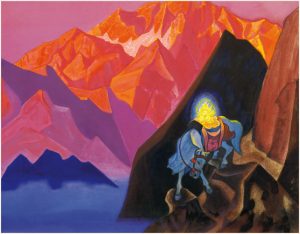The achievements of science that have appeared on the horizon over the last 100 years are also part of the content of a contemporary theosophy. Two important ones should be mentioned here as examples: the results of quantum physics, without which our modern technical communication would not be possible, and special insights into human communication.
With regard to the second, this text explains how an arc can be drawn to the necessary abilities that a spirit soul needs in order to orientate itself in the afterlife and in sleep/dream and to be able to move (wander) purposefully.
For Richard Bandler, all his research results are brain-bound phenomena. From an occult point of view, however, they are more than that. Anyone who encounters an angel and later reports that they had a hallucination has nevertheless encountered the angel, even if they do not realise it.
Basically, the two books mentioned later are intended for those readers who have made first contact via the Bridge to the Higher Mind, i.e. who have overcome the astral and mental difficulties and can wilfully avoid the danger of entanglement in these spheres. Even if the first contact via the bridge is not yet steady, the path to a conscious presence in the afterlife is made possible.
At this point, a concept as broad as that of incarnation should be supplemented by an aspect that is rarely considered:
If the energetic bridging has succeeded in the beginning and the bridge is being worked on, the after-death is not the path to a resting place of the spirit soul, but the path to a possible further presence. If it succeeds, even with higher help, it lasts until the next physical incarnation. In the sense of such a presence, one must therefore speak of a real further incarnation that takes place in a shell adapted to the higher circumstances / levels.
In the physical incarnation, our brain consciousness habitually “programmes” us daily with the limited dimensions of earthly physics. The reality proven in quantum physics that a thing can be in two places in space at the same time is an example of how this dimensional limitation, which our untrained brain conveys to us on a daily basis, breaks down. To be able to walk the path across the bridge of knowledge – the stones of the subtle bridge consist of the accumulated knowledge of the teachings – the inclusion of the results of modern human communication theory is a sensible choice.
R. Bandler and others have achieved groundbreaking results in the science of human communication. The curious term “neuro-linguistic programming” (NLP) has led to fundamental changes in therapeutic practice. The contents have also found their way into many other areas, both negatively manipulative and beneficial.
Theosophists who study the developed theory will find certain parallels to the core ideas of ZEN and TAO.
Therapeutic applications are not the subject of this text. If you are interested, you will find a reference to two books at the end.
Based on the typology of our individual sensory centres, Bandler shows modalities that influence perception differently. The visual, auditory or physical processing of sensory impressions leads to results in our personality that accompany us throughout our lives. In many cases, however, this also results in obstacles that can make life considerably more difficult or cause illness.
There are no obvious references to theosophy in all the literature on NLP, and yet it is characterised by a lively and philanthropic way of thinking that would suit many a theosophist.
Modalities in the sense of this science are tools for our actions in thinking, feeling and physical perception. R. Bandler’s simple principle is the question: “Am I driving the bus or is it driving me?”
The simplicity of this question demands an answer, and we can formulate it differently: Am I shaping what is happening in the astral and mental, or is it doing to me what it wants or what I don’t want? This question is important both in the present physical incarnation and in a possible incarnation in the non-physical realms after the transition. Especially in the time after physical death, knowing and practising the modalities considerably shortens the time needed to come to terms with the past life. We know that this takes at least 40 days of earthly time, but it can become many years of wandering. In Supermundane, Mahatma M. describes the unimaginable mental suffering of people who either seek the falsely promised reward (paradise) or find themselves as extreme deniers of the spiritual in something that should not even exist. The mental suffering in the second case is unspeakably great.
The elementary meditation of circle and point, which was already suggested here in one of the first texts, is an exercise for lively thinking in the modalities and helps to intensify the path of creative activity.
Elements of the modalities are also presented as examples in the text “Movement” (in the blog).
If R. Bandler succeeds in tolerably changing or self-healing various emotional and mental disorders through the application of the modalities he has researched, this confirms the assumption that the human individual has the ability to create.
Every night, our ego, freed from the physical, sets off on its journey into these spheres. The easier and more dynamic the path to the “bridge”, the greater the gain in realisation. Those who can cross over, cross over. Those who work on the bridge shape it. The decisive factor is the activity of action.
A not uncommon example may illustrate what activity means in this context.
In dreams from different stages of life, standing on a precipice is repeated, combined with fear and often with a stressed awakening. The decision in the dream to simply jump involves the volitional mental activity that solves the astral problem. This process can only be solved in the dream itself.
An example of the application of the modalities in outer life (for predominantly visual individuals) is to give any fear an image in the imagination, then limit this image in space, thus detaching it from space itself. The image can now be enlarged or reduced in size. It can be sharp in contrast or milky as in a fog. It can be shifted in space to the left, right, up or down. It can be moved in two modalities in space at the same time, far away from the horizon and at the same time become a point.
After each mentally active step in the visualisation, the effect of the changed image on one’s own feelings is checked and the best possible “position” for overcoming anxiety is found. In the next step, the rest of the image, probably a point in space, is “fixed” in its new position.
After each mentally active step in the visualisation, the effect of the changed image on one’s own feelings is checked and the best possible “position” for overcoming anxiety is found. In the next step, the rest of the image, probably a point in space, is “fixed” in its new position.
The author is aware that this opens up a wide field of research for the reader. However, it is only intended to provide a partial supplement to the teachings, addressing essential elements that play an important role in sleep/dream and in the afterlife. For many readers who take away a basic understanding of the teachings, there will be a hand extended from above in the afterlife to guide the way. The path over the bridge leads to a community in which the individual expresses itself through the ability to organise the common group life (ashram) in unconditional agreement. Everyone has an assigned job and also a freely chosen area of research and study. You think this does not apply to you yet? Then these texts give you the opportunity to accelerate the process towards your goal through repeated study.
For all those interested:
Richard Bandler: – Meta Publications: An Insider’s Guide To Sub-Modalities 1988 – Junfermann: The Subtle Difference; Exercise Book on Submodalities 1990
Richard Bandler: – Real People Press: Using Your Brain – For a Change 1985 – Junfermann: Changing Subjective Experience 1987
The first book is suitable for a brief methodological overview, the second is more fundamental and detailed.
The possibilities associated with this therapeutic revolution have not caught on because the “classical” therapists do not want to do without the question of “why” and continue to hold countless sessions to search for the causes of a phobia that can be erased in 30 minutes using the NLP technique because it is usually based on an astral-mental misunderstanding or was simply astrally transferred from parent to child. Everyone can answer the question of “why” this method has not become widely accepted for themselves. The lack of recognition of the truth of reincarnation can be cited as an example.





